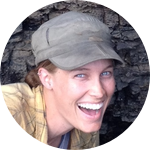About This Project
The DIG Field School helps make science exciting and relevant for students by giving teachers the chance to be part of real paleontology research and bring that research into their classrooms. Teachers dig up dinosaurs and other fossils, get professional development, and students get real inquiry-based science projects and activities - everybody wins! Wondering what exactly teachers do during the DIG Field School? Check out our video! See footage and photos from the field and hear from teachers from our 2012 Field School.Ask the Scientists
Join The DiscussionWhat is the context of this research?
The DIG Field School helps make science exciting and relevant for students through the power of dinosaurs. Because who doesn't love dinosaurs?
DIG helps teachers bring real science into their classrooms to share with their students. In addition to an amazing hands-on learning experience, DIG also provides teachers with professional training in geosciences and science education - and it's completely free.
The DIG Field School brings K-12 teachers to Hell Creek, Montana for a 4-day, immersive field research experience. Teachers work and learn side-by-side with University of Washington paleontologists: excavating dinosaurs and other fossils, collecting data, and developing research skills and experiences that they can bring back to students in their classrooms. Teachers also have the chance to bone up (pun intended!) on biology and geology, especially evolution and deep time. The data they help collect furthers ongoing research about the extinction of dinosaurs and the rise of mammals, which teachers and students will be able to follow on the DIG website.
Back home from the field, teachers will have ongoing access to educational resources from the DIG website and staff, including the DIG Box. The DIG Box is full of resources teachers can use, from lesson plans (such as “Dinosaurs’ Demise”) to fossil replicas (like a replica T. rex tooth!).
What is the significance of this project?
We know this model of professional development for teachers works; the result is better inquiry-based experiential science education for students.
In the first three years of the DIG Field School, we've reached over 800 students. With $10,000, we can reach more than 20 teachers and 1,000 students. We aim to offer two DIG field schools in 2014, and in 5 years we estimate that we can reach over 10,000 students.
By providing experience and professional development for teachers, the DIG Field School not only helps current K-12 students, but also helps prepare teachers to meet President Obama's goal of training 100,000 new STEM (Science, Technology, Engineering, & Math) teachers over the next decade. Teacher who participate in the DIG Field School will also be equipped to teach students the same practices professional scientists use in their research. They'll also come back from the field with great stories to share and a (ignited or reignited) passion for science!
The DIG Field School specifically prepares teachers to be competent and confident in teaching and discussing issues in biology and geology such as evolution and geologic time - topics on the front lines of the evolution vs. creationism debates. The DIG Field School allows teachers to reveal for themselves the direct fossil evidence for evolution in 66 million year old deposits.
What are the goals of the project?
Participation in the DIG Field School is free for teachers and includes:
- 4-days at a fossil dig site in Montana, participating in a professional development experience at an internationally recognized and active paleontological field research site
- Lesson plans and course materials for participants’ students
- Continuing Education Units for participant teachers
- A website to provide teachers with educational resources, a hub for updates, and communication with UW researchers, DIG staff, and other teachers
- Ongoing contact with UW researchers and DIG staff, including virtual or in-person visits to K–12 classrooms
The entire price for the field school is approximately $8,000, but that doesn't cover the cost of transport for the teachers. In previous years, teachers have paid out of pocket for the cost of gas or airfare to travel to the field site in northeastern Montana. With $10,000, we can fully fund one 2014 field school, including field supplies, course materials, and food for 20 teachers and 5 staff. We also seek to provide a $100 stipend for each teacher to help defray the costs of travel.
Budget
The budget for the field school covers everything except transportation to and from Montana for the participant teachers. We provide the food, supplies, field manuals, instruction, transportation around the area, and in-class visits when the field school is over for a total cost of $8,000.
At this time, DIG teachers have to get themselves to and from Montana, and in the past we have had teachers that could not attend because of the travel costs. The extra $2,000 will allow us give each teacher a stipend minimum of $100, helping them to attend the field school and ultimately share their experience with their students.
Meet the Team
Affiliates
2005-2007 Curator of Vertebrate Paleontology, Denver Museum of Nature
2004-2005 NSF Postdoctoral Fellow, University of Helsinki, Finland
2004 PhD, University of California, Berkeley, Department of Integrative Biology
Affiliates
2008-Present PhD Candidate, University of Washington, Department of Biology
2008 BA, University of California, Berkeley, Department of Integrative Biology
Team Bio
My research examines evolution and ecology of early mammals in the context of major events in earth history through fieldwork, systematics, and quantitative functional analysis of modern and extinct species. Current research projects focus on three broad topics:- Mammalian change across the Cretaceous-Tertiary boundary
- Mammal tooth shape and diet
- Biogeography of Cretaceous mammals
Gregory P. Wilson
My research examines evolution and ecology of early mammals in the context of major events in earth history through fieldwork, systematics, and quantitative functional analysis of modern and extinct species. Current research projects focus on three broad topics:
- Mammalian change across the Cretaceous-Tertiary boundary
- Mammal tooth shape and diet
- Biogeography of Cretaceous mammals
Lauren B. DeBey
Background:
My research examines the ecology of the small mammals that survived the mass extinction that killed the dinosaurs ~66 million years ago, using fieldwork, research on museum specimens, and comparisons of modern mammals to assess locomotion and body size.
Additional Information
Learn more about the Dig Field School - and apply to participate - here.
If you'd like to donate anonymously to our campaign, you can write a check to UW Advancement. For more information on donating anonymously, feel free to contact DigFS@uw.edu, UW Advancement, or Cindy at Microryza.

Project Backers
- 53Backers
- 104%Funded
- $10,470Total Donations
- $193.89Average Donation

